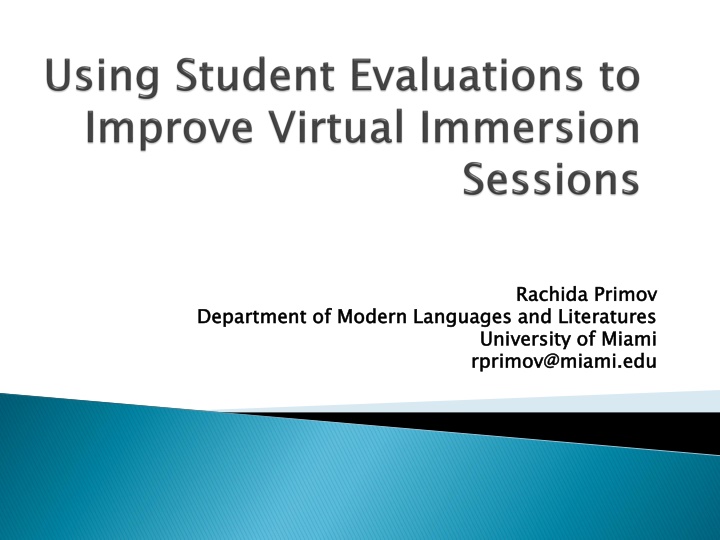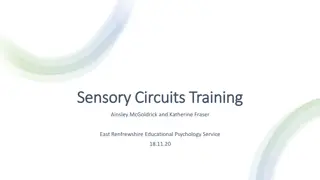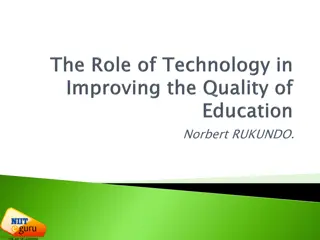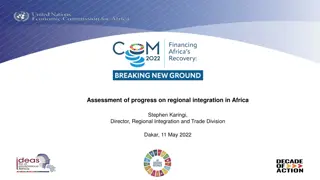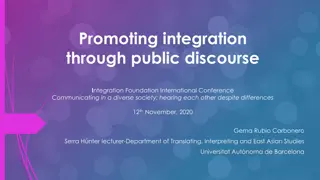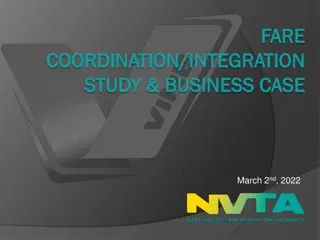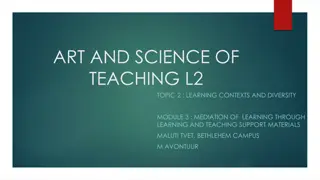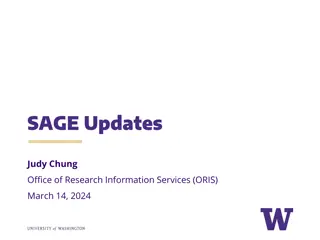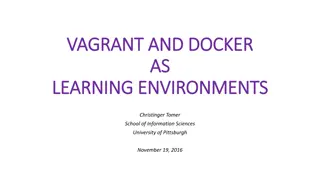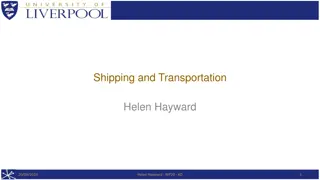Enhancing Learning Environments through Efficient Technology Integration
The Department of Modern Languages and Literatures at the University of Miami implemented strategies to optimize the learning environment using technology. By encouraging the use of lab computers, pre-logged Skype accounts, and efficient technical support, they improved student collaboration and minimized technical disruptions. These initiatives led to high student satisfaction and improved session success rates.
Download Presentation

Please find below an Image/Link to download the presentation.
The content on the website is provided AS IS for your information and personal use only. It may not be sold, licensed, or shared on other websites without obtaining consent from the author.If you encounter any issues during the download, it is possible that the publisher has removed the file from their server.
You are allowed to download the files provided on this website for personal or commercial use, subject to the condition that they are used lawfully. All files are the property of their respective owners.
The content on the website is provided AS IS for your information and personal use only. It may not be sold, licensed, or shared on other websites without obtaining consent from the author.
E N D
Presentation Transcript
Rachida Rachida Primov Primov Department of Modern Languages and Literatures Department of Modern Languages and Literatures University of Miami rprimov@miami.edu University of Miami rprimov@miami.edu
Student Evaluations 205 Lab calendar 201 Lab calendar
Q1 The lab facility/equipment contributed to a positive learning environment S10 F10 S11 F11 S12 F12 S13 F13 Average 95 99 92 98 91 97 98 92 91
At the beginning, we encouraged our students to use their own computers, assuming that they would prefer to do so and that it would be more efficient. We quickly learned that it was much more efficient for everyone to use the Lab computers. This allowed us to give the same instructions and procedures to all students, thus avoiding the operational idiosyncrasies of different computers and programs. Furthermore, this approach facilitated the process of allocating session partners by randomly assigning students to a Lab computer and, thus, simultaneously to a partner.
Q2 Having Lab accounts already logged into Skype contributed to the success of the session S10 F10 S11 F11 S12 F12 S13 F13 Average 92 93 94 79 97 93 93 98 91
Having all computers connected before the students arrive for a session, not only provides maximizes the time that students can interact with their partners, but has three additional advantages: It allows the staff to identify and solve any unexpected technical or connective problems that may arise immediately before each session. 1. Students do not need to use or create personal Skype accounts. 2. All students can start and end their sessions at the same time. 3.
Q3 The Lab staff was able to resolve technical issues in a timely manner S10 F10 S11 F11 S12 F12 S13 F13 Average 88 88 85 81 86 96 91 92 84
Although self-evident, the issue of technical support is crucial for a successful session and for student satisfaction with the session. Immediate technical help to resolve connectivity problems makes a significant difference in how well sessions proceed. Long pauses caused by technical problems tend to undermine the rapport developed by partners and result in frustrated students who do not benefit very much from the session.
Q4 Skype is an effective tool for communication and cultural immersion S10 F10 S11 F11 S12 F12 S13 F13 Average 91 96 93 85 92 97 91 84 92
The primary lesson here is that students are very enthusiastic about virtual immersion sessions and that once they get over their initial apprehension about having to speak the target language to a native speaker in real time, they become excited at having actually communicated in the target language and were quite ready to repeat their experience. A secondary lesson is that our students found it quite satisfying to be able to help their partners communicate in English. This was especially true when the topics of conversation were about everyday life issues and cultural preferences.
Q5 I liked/enjoyed the experience of using Skype for this cultural experience S10 F10 S11 F11 S12 F12 S13 F13 Average 86 97 85 79 93 90 89 80 75
We learned here that our initial apprehensions that the utilization of technologies like Skype, for conducting dialogues between students that were strangers to each other and that came from different cultures and spoke different languages, would create additional constraints on their ability and willingness to participate and engage successfully with each other. We found out that, on the contrary, students on both sides of the partnerships, were so familiar and comfortable with Skype that instead of being a distraction, it facilitated social exchange. In fact, it may have made the interactions less awkward than they would have been had the students engaged in the same task had they been both physically present with each other.
Q6 I thought that this was a useful experience S10 F10 S11 F11 S12 F12 S13 F13 Average 88 95 87 78 93 90 94 86 84
Students regarded their first session with some trepidation but once they were done, they seemed to enjoy the realization that they could actually converse in the target language. For many of them, this is quite a realization. Learning foreign languages is commonly seen by students as a difficult and uninteresting task of just learning nouns, conjugating verbs and memorizing idiomatic expressions, with no real purpose, all of a sudden had an interesting and unexpected payoff they could actually speak to someone and be understood! What we have learned from this is that it is never too early to expose our students to immersion sessions because it provides them with a positive reinforcement when they actually do something with the language that they have started learning and it gives them with an incentive to learn the language.
Q7 If this experience were part of your regular course, how often do you think you should be meeting with the other class? S10 25 47 23 2 3 F10 26 54 20 0 0 S11 18 45 24 8 5 F11 22 31 35 12 0 S12 42 27 25 2 4 F12 36 31 26 4 3 S13 13 33 41 10 3 F13 18 37 32 10 3 Average 25 38 28 6 3 Weekly Biweekly Monthly Bimonthly By arrangement with partner
The lesson learned from the responses to Q6 must be tempered by what we learn from Q7. Although students were very positive about their experiences with an immersion session, it is also clear that the experience was stressful for many of them and that they would not welcome a very frequent exposure to them. It appears that even one weekly session would be a bit too much. There is a strong preference by the students for a biweekly sessions. We should heed this as a cautionary note against scheduling too many immersion sessions in any course in order to avoid the sessions becoming uninteresting or too routine.
Q8 What kind of partner interaction would you like? S10 F10 S11 F11 S12 F12 S13 F13 Average Same partner all semester Different partners 39 61 33 67 36 64 41 59 17 83 36 64 26 74 43 57 34 66
The lesson here is that a significant majority of the students prefer to be paired with a new student each session. One conclusion about this preference is that students view the immersion sessions as an opportunity to meet new people their age, especially if they are from another country, and to meet as many of them as possible. Another conclusion, is that from a pedagogical point of view, it is probably better to avoid pairing up the same students because they are more likely to go off topic or run out of topics to discuss.
Q9 Do you think that this should be a graded activity? S10 F10 S11 F11 S12 F12 S13 F13 Average Yes No 27 78 10 90 40 60 38 62 35 65 30 70 30 70
The important lesson to be drawn from the responses to this question is that this is not a very good question, since the responses to it are highly predictable. Students view the immersion sessions as an enjoyable experience and do not feel that it should be a graded component of their course. Instructors who wish to grade the sessions may want to wait and grade only the last, or last two, sessions. Presumably, by then, having had experience with one, two or three previous sessions, students will be more at ease and will perform better under graded conditions. If a grade has to be involved, then the effort as much as the outcome should be considered.
Q10 Given the choice between choosing a class with or without virtual immersion sessessions, which would you choose? S10 F10 S11 F11 S12 F12 S13 F13 Average With 59 17 24 73 9 18 76 8 16 70 1 29 53 15 32 59 9 32 65 10 25 Without Either
Clearly, most students would choose a class with an immersion session component, if they had a choice. This shows strong support for the program. A small minority would prefer a class without an immersion session component. But what about the twenty-five percent of students who seem indifferent to the experience? We suspect that they are indifferent for several different reasons. They may have had disappointing sessions, the sessions may have been too stressful for them, they may have disliked their partners, they may be very shy and introverted, or they may not have had enough sessions to become comfortable with them.
